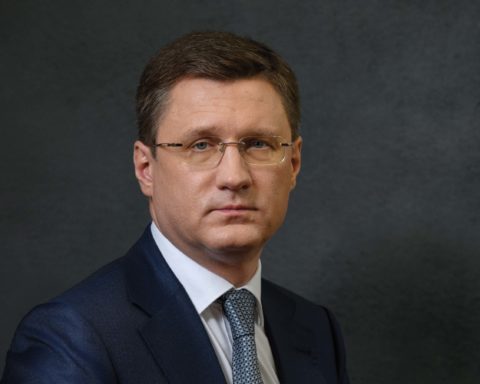Alexander NOVAK
Deputy Prime Minister of the Russian Federation
The climate agenda and the desire to maximize decarbonisation of the global economy are becoming more widespread in many countries of the world. To a large extent, this trend has also affected the energy complex, where in recent years there has been an increase in investments in the development of the FEC alternative branches. Russia has traditionally been the world leader in the production and supply of energy resources. Our goal is to preserve and increase achievements in this direction, therefore, over the past years, Russia has been actively building up its competencies in the field of “green” energy sources, so that, in any vector of energy markets development, it stably meets domestic energy needs and remains a reliable and competitive long-term supplier of the energy resource products.
International regulation of the climate agenda
The first step towards formalizing
approaches to reducing anthropogenic impact on the environment was the
Intergovernmental Panel on Climate Change, created in 1988, whose activity in
2007 was awarded the Nobel Peace Prize “for their efforts to build up and
disseminate greater knowledge about man-made climate change, and to lay the
foundations for the measures that are needed to counteract such change”.
Currently, global energy policy is
governed by the 1992 United Nations Framework Convention on Climate Change. The
purpose of the document is to achieve stabilisation of the greenhouse gas (GHG)
concentrations in the atmosphere at a level that would preclude dangerous
anthropogenic impact on the climate system. It is assumed that developed
countries shall take the leading role in counteracting the negative effects of
climate change.
In December 1997, at the conference of the parties to the UNFCCC in Japan, the Kyoto
Protocol was adopted, whose main feature was the legally enshrined quantitative obligations of developed countries and countries with economies in transition to limit and reduce the emission of greenhouse gases into the atmosphere. Russia joined the Kyoto Protocol in 2004, undertaking quantitative commitments to maintain the level of greenhouse gas emissions in the first period of the Kyoto Protocol (2008-2012) at the 1990 level. Herewith, Russia is one of the few countries that overfulfilled their obligations under the Kyoto Protocol in the first period of its operation. Greenhouse gas emissions have decreased by 31% compared to the 1990 level.
The Paris Agreement, which was
concluded in 2015 on the basis of the UN Framework Convention on Climate
Change, gave a new impetus to the work to counteract global warming.
Since 1990, the greenhouse gas emissions in China and India have increased by 3.5 and 2.6 times, in the USA they have remained practically unchanged, and in Russia and the EU they have decreased by 30.3% and 22.3%, respectively.
The document regulates measures to reduce the content of carbon dioxide in the atmosphere from 2020 and sets the goal “to keep the increase in the global average temperature below 2 °C above pre-industrial levels and to make efforts to limit the rise in temperature to 1.5 °C.” Herewith, the peak of СО2 emission shall be reached as soon as possible. Each of the 190 parties to the Agreement determines its contribution to the achievement of the declared common goal on an individual basis, revising the benchmarks every five years.

Source: T Plus
Russia joined the Agreement in 2019 and committed to achieve up to 70% of greenhouse gas emissions from 1990 level by 2030.The FEC’s role in this process will be significant.
Environment and the influence of the FEC on the climate
The growth of anthropogenic emissions in the today’s world is on an upward trend. The largest emitters of greenhouse gases (GHG) in absolute terms are China, the USA, the EU, India, Russia and Japan. Since 1990, greenhouse gas emissions in China and India have increased by 3.5 and 2.6 times, respectively, in the USA they remained practically unchanged (an increase of 1.8% by 2019), while I emphasize that in Russia and the EU – decreased by 30.3% and 22.3%, respectively.
The analysis shows that the energy sector contributes significantly to greenhouse gas emissions in all countries. This being said, the UN estimates that global emissions of energy-related pollutants fell in 2020 by almost 8% to the lowest level since 2010, but for the most part this is not associated with the global trends, but with the coronavirus restrictions.
Herewith, a number of countries
continue to take the initiative to phase out fossil fuels, which would make it
possible to achieve full compensation for emissions by their absorption.
European states intend to achieve carbon neutrality by 2050, China has
announced its intention to achieve carbon neutrality by 2060. Plans to
eliminate coal-fired generation are outlined in more than 20 countries, and the
list continues to grow: similar plans are also being discussed by the Czech
Republic, Spain and North Macedonia. In Asia, the main region for coal
consumption, the possibility of limiting coal generation and phasing out
inefficient capacities is being considered. There are separate initiatives to
phase out fossil fuels for transportation and to ban exploration and mining.
Large financial corporations have already reacted to the strengthening of the
climate agenda by shifting investments into the green energy segment instead of
financing projects in the extraction, processing and transportation of oil, gas
and coal.
Against this background, a discussion is developing on the possible implementation of the carbon border adjustment. Despite the fact that such a concept is absent in the Paris Agreement, in 2020, within the framework of the European Union, similar initiatives were announced, which brings the issue of carbon pricing to the international level. Currently, the form of entry, the method of implementation and the methodology for calculating such a fee are still being discussed. It is expected that Carbon Border Adjustment Mechanism (CBAM) will be implemented from 2023.
The baseline scenario assumes
that at the first stages of the CBAM can only apply to the processing industry
products. However, the development option, in which the tax may affect raw
materials in the coming years, in particular, oil, gas, coal, is not yet
excluded. Herewith, a number of analysts believe that the nature of
intensification of work on the implementation of carbon regulation may be not
only ecological, but economic as well. The European Commission has developed a
financial assistance plan to bring the EU economy out of the crisis caused by
the COVID-19 pandemic, and the CBAM implementation is one of the expected
income items (5-14 bln EUR per year in 2021-2027).
Therefore, it is currently important to be ahead of the curve and assess in advance the possible risks from the CBAM implementation. According to the BCG experts’ analysis, oil and gas, metallurgy and mining sectors are among the main sectors that may suffer losses.
I would like to remind that the United Nations Framework Convention on Climate Change emphasizes that climate change counteraction measures shall not serve either as a means of unjustified discrimination or a hidden restriction of international trade.
Herewith, many experts note that the CBAM implementation may violate a number of WTO principles and the UNFCCC provisions. We believe that, since the issue affects the interests and needs of a number of countries, when finding compromise solutions, first of all, it is necessary to be guided by the norms of international law.
Herewith,
there is another important circumstance: leading analysts agree that energy
consumption in the world will grow, and new demand cannot be met without
traditional energy resources. Artificial restrictive measures of the
traditional sectors of the FEC can reduce the profitability and investment
attractiveness of the industry, as a result, there will be a threat to the
reliability of energy supply.
Therefore, we are confident
that at every stage of the energy transition it is necessary to continue uninterrupted
supply of energy to people and economies, and at an affordable price for
consumers. We must not forget that energy, first of all, shall serve humanity.
In this regard, the carbon tax implementation may not be an instrument of
unfair competition and thereby endanger the energy security of the continent.
Environmental policy of Russia and the FEC
The consequences of climate change are attributed to the challenges in the Environmental Security Strategy of the Russian Federation for the period up to 2025, and the building up of international efforts to implement climate policy and accelerate the transition to a “green” economy – to the challenges of the Energy Security Doctrine of the Russian Federation. The direction on environmental protection and counteracting climate change was included in the Energy Strategy of the Russian Federation for the period up to 2035. Thus, climate policy is among the priorities of the state, and a number of interdepartmental working groups have been created to coordinate it.
At the summit of leaders on climate issues in April this year, President of the Russian Federation V.V.Putin once again stressed that the fate of our entire planet, the prospects for the development of each country, the well-being and quality of life of people largely depend on the success of efforts on climate change.
Currently, Russia is working on measures to oppose the climate change, which, first of all, directly or indirectly stimulate the reduction of anthropogenic greenhouse gas emissions and contribute to improving the quality of sinks and storage tanks. The initiatives have both general economic and sectoral focus.
If we talk about the energy
sector, then this is mandatory reporting on greenhouse gas emissions for
generation with a capacity of more than 500 kW, construction of a new
generation (Capacity Supply Agreement/ДПМ) and modernisation of old generation
(Competitive Capacity Auction/КОМ-мод) in the wholesale market, as well as
modernisation of inefficient diesel generation, stimulation of reduction of
losses in electric and heating networks, modernisation of oil refining capacities, support of RES, launch of a system of “low-carbon” certificates.
Moreover, the draft of a
new comprehensive plan to enhance energy efficiency envisages a 35% reduction
in the energy intensity of Russia’s GDP by 2030 compared to 2017. According to
IEA analysts, it is energy efficiency that shall provide more than 40%
reduction in greenhouse gas emissions associated with energy.
As for traditional
hydrocarbon energy sources in the context of the climate agenda, the cleanest
of them today is natural gas, that is, it can be easily attributed to promising
environmentally friendly energy resources. In this regard, the commissioning of
export gas pipelines continues, and the use of gas within the country is
expanding. By 2030, the level of gasification of Russian regions should reach
almost 83 %. Moreover, the
infrastructure for the use of gas motor fuel in transport is being developed.
Compared to 1990,
emissions in Russia have halved – from 3.1 bln t of СО2 equivalent
to 1.6 bln t, and now more than 40% of our energy balance is made up of
carbon-free energy sources – NPPs, HPPs and other RES.
We intend to continue to implement a large-scale program of environmental modernisation and energy efficiency in all sectors of the economy, to ensure the capture, storage and use of carbon dioxide from all sources.
As a result of the current state program to support GMF, the total consumption of natural gas as a motor fuel in 2020 increased by 10% in annual terms to 1.1 bln cub.m, and the number of filling stations increased by 20% and exceeded 600 units.
Moreover, to date, a significant reduction in methane emissions has been achieved both in the transportation of natural gas and in the production of oil.
The APG utilisation factor on average in Russia increased from 75.5% in 2011 to 81.5% in 2019.
Pursuant to the
energy strategy, the APG utilisation should be 95% by 2035.
It shall be noted that the increasing rates for the flaring of associated gas in excess of 5% are constantly growing (from 4.5 in 2012 to 100 in 2020), encouraging companies to reduce emissions.
Owing to the work on the decommissioning of obsolete equipment and the modernisation of existing facilities, in 2020 the decrease in greenhouse gas emissions into the atmosphere of Russian TPPs amounted to 7.5% compared to 2014 (an average decrease of 2.3% per year). The implementation of technologies for combined generation of heat and electricity
Artificial restrictive
measures of traditional sectors of the FEC can reduce the profitability and
investment attractiveness of the industry, as a result, there will be a threat
to the reliability of energy supply
is also underway, which will reduce greenhouse gas emissions in the field of heat supply. Today, 17 municipalities have already switched to a new model of heat supply using the “alternative boiler house” method, and the issue of switching to a new model is being considered in at least 16 more municipalities.
Considerable attention is paid to expanding the
use of renewable energy sources (RES). The current RES support program, which
started in 2014 and ends in 2024, has already demonstrated its efficiency. Over
the past 7 years, 2.4 GW of RES have been commissioned, of which 1.2 GW in 2020
(+127% by 2019). By 2024, the total volume of installed capacity of power
plants built under the RES support mechanism will be almost 6 GW. Target
indicators for the volume of production and consumption of electricity using
RES (except for hydroelectric power plants with an installed capacity of more
than 25 MW) are fixed at 4.5% by 2024. Herewith, a new RES support program for
the period 2025-2035, whose main task is the transition of the established
industry to a fully competitive regime, was approved in March.
Localisation requirements and the implementation of export obligations are increasing as well.
Work continues on the modernisation of industry, the formation of lists of the best available technologies in various industries, we are implementing programs of state support for increasing the energy efficiency of the electric power industry based on the use of renewable energy sources.
Nuclear energy today is also considered environmentally friendly and safe. Many countries are gradually returning to its use.
Among the urgent tasks is the development of hydrogen energy, which is currently used mainly in industry. The task for the near future is to introduce this type of energy resources into other industries, including energy, transport, energy storage technologies.
In this regard, the implementation
of technologies for the production of hydrogen both from natural gas and
electrolysis, as well as the stimulation of domestic demand for hydrogen is
being actively performed. Domestic companies Gazprom and Rosatom are
considering the possibility of implementing export-oriented projects for the
production of hydrogen using technologies for steam reforming of methane and
high-temperature electrolysis at nuclear power plants.
Potential volumes of hydrogen exports from Russia may amount to 2-7 mln t in 2035 and 7.9-33.4 mln t in 2050, depending on the pace of development of the global low-carbon economy
Potential volumes of hydrogen exports from the Russian Federation to the world market can reach up to 0.2 mln t in 2024, up to 2-7 mln t in 2035 and 7.9-33.4 mln t in 2050, depending on the pace the development of the global low-carbon economy; and the growth of demand for hydrogen in the global market.
I would like to emphasize that our country intends to increasingly participate in the development and implementation of green energy technologies. Herewith, we are also convinced that it is necessary to maintain a balance of hydrocarbon, nuclear and renewable energy for a harmonious energy future. Fossil energy sources can be environmentally neutral, considering the development and application of modern technologies, while maintaining their main advantage – reliability, which is especially important in the modern world.







